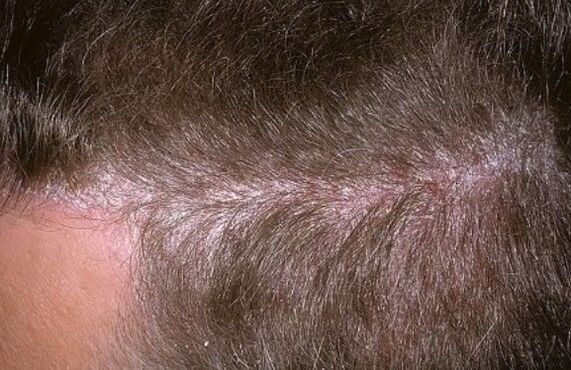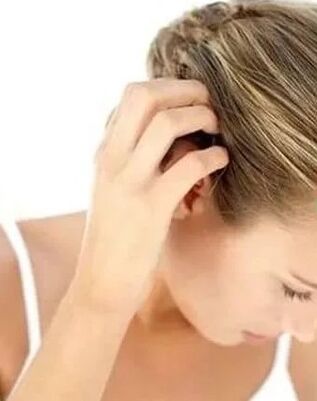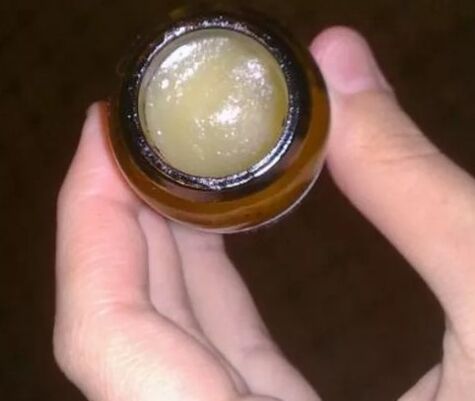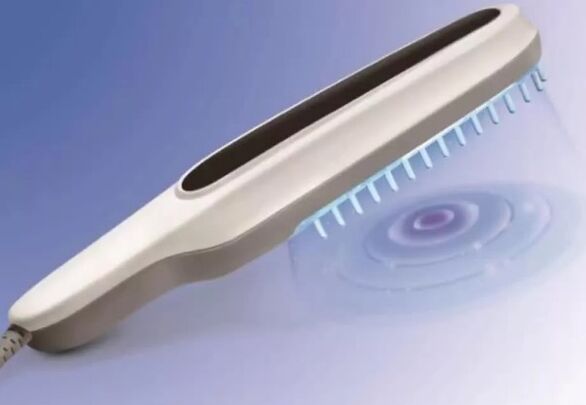Psoriasis on the head is one of the most common forms of psoriasis.It can be an independent variant of the disease, when psorial eruptions are found only on the head (regional psoriasis of the scalp) or can be related to the manifestations of generalized and widespread shapes, when pathological changes capture the entire surface of the skin.

Causes of the disease
The causes of psoriasis on the head are the same as that of the psoriasis of other locations.However, none of the many theories of psoriasis is universally recognized and, despite the enormous number of studies, the true causes of the disease are still unknown.However, the factors are distinguished, whose role is demonstrated in the development of the disease.
- Inheritance.In about a third of the patients, psoriasis is inherited according to the classic laws of genetics: from parents to offspring, according to the dominant autosomal mechanism.In other cases, psoriasis refers to multifactorial to diseases, when hereditary factors increase the risk of illness in the presence of other significant effects.
- Immune, endocrine, metabolic disorders.
- Epidermic disorders: various types of changes in the life cycle of skin cells, including the greatest value is attached to the abnormal proliferation of keratinocytes (acceleration of the skin division of the skin) and a slowdown of morphological differentiation (maturation and division into different types of cells).
The main symptoms
The main local symptom of the head psoriasis is the thread thickened, clearly delimited and plaques of pink color or bright red with a characteristic peeling of silver white on their surface.Typical location: the forehead and the freezing area on the border of the hair growth area.At the beginning of the disease, there are usually few plates, they are pale and, so to speak, deleted, preserved for a long time in the same places.After exposure to provocative factors (trauma, infection, pregnancy, diet, nervous shock, etc.), the rash progresses.The plains increase in size, merge, become brighter, itching.Hair with psoriasis does not fall, even in the case of a severe route and large injuries of the scalp.
When the surface of the plates appears, it is possible to determine the characteristic triad of the symptoms:
- The phenomenon of the Stearina point is an increase in peeling with a slight stage object.
- The phenomenon of the terminal film - After removing the stairs, the surface of the plate becomes wet, thin, shiny.
- The symptom of Auspitz, or a phenomenon of bloody dew - with the carefully propagation of the terminal film, punctual bleeding occurs in the form of small drops of non -commercial blood.

In addition to local symptoms, some patients develop psoriatic nails and arthritis injuries.
Treatment
The treatment of psoriasis on the head should be complex, including the correction of possible causes and eliminate provocative factors, diet therapy and general and local funds.Specific recommendations for skin care and the choice of drugs in each case are individual and should give them a dermatologist.
Unfortunately, today it is not known how to completely cure psoriasis: the disease is chronic, inclined to frequent recurrences.However, the complete fulfillment of all appointments can provide a long persistent remission, when the symptoms of the skin become inconspicuous or completely disappear.
Diet
The diet of patients with psoriasis is similar to the diet of patients with allergies, since they are allergic mediars (Istamine and others) that support acute changes in the skin.So, they are excluded from the diet:
- Mining substances (broths rich in meat and fish, smoked meats).
- Spices, condiments.
- Products with a large number of artificial flavors, dyes.
- Marinates, Sauerry and salt vegetables, canned food.
- Mushrooms.
- Alcohol.
- Exotic fruits (mango, kiwi, etc.).
The fat and fried dishes are limited, easily digestible carbohydrates (desserts, pasta, butter cooking), table salt.Against the background of the exacerbation, it is recommended to conduct unloading days, with intense rashes: one day hunger twice a week.
Skin care
Even with a serious itching, the skin should be avoided, since the lesions to the plates often contribute to the appearance of new rashes (Kobner phenomenon).To relieve the itching and removal of the stairs, they wash every day, alternating the use of special shampoos and decoctions of anti -inflammatory herbs.Shampoo from head psoriasis can contain:
- tar;
- Selena sulfuro;
- zinc.

Shampoo is used no more than three times a week and among these procedures it is recommended to wash the head with a decoction of chamomile, calendula, sage, pine extract and tea leaves.
Drug
The treatment of psoriasis on the head in case of serious exacerbations can be carried out in a hospital, with the prescription of systemic corticosteroids (orally or intramuscularly), desensitizing the therapy (antihistamines inside and intramuscular).Hangling, intravenous administration of sodium thyosulphized, calcium chloride, intramuscular intramuscular injects of calcium gluconate (or prescribed inside) is carried out.
In addition, with severe and moderate psoriasis, it is possible to prescribe the following groups of drugs (rigorously based on the indications and individually!):
- Cytostatic (Methotrexate, cyclosporine) - to suppress the proliferation of abnormal cells.
- Retinoid of the system - to regulate the processes of regeneration and differentiation of skin cells.The drug is not combined with cytostatic and other retinoids.
- Biological agents of the system: reduce the activity of the immune system.
Local funds
With large skin manifestations, in particular with elements of acute inflammation, exudation, in the presence of combs, local funds are used limited and extremely carefully, since the active penetration of active substance is possible through damaged skin with the development of systemic side effects.In the exacerbation phase and during the partial remission period, local drugs are beginning to apply in the exacerbation phase constitute the basis for the treatment of psoriasis.
In addition to therapeutic shampoos and anti -inflammatory decorations, pastes, ointments, creams, gels, lotions.The following drugs are more often used:
- The local funds containing tar are applied to the scalp twice a day with 1-2 weeks courses.It is not advisable that they are treated for a long time without interruption, as they can cause excessive dry skin.
- Naftalan ointment.
- Salicylic ointment.Salicylic acid has a keratolithic effect ("dissolves" coarse cells), disinfects the surface of the plates.
- It means with zinc.
- Local forms of glucocorticosteroids.In order to avoid the development of local skin changes (steroid acne, irritation, thinning, atrophy, allergic dermatitis) and systemic side effects (metabolic, hormonal disorders, etc.) corticosteroids are prescribed within two weeks 1 time per month.They should be applied twice a day with a thin layer and only on plates, whose surface has no mechanical damage (combs, erosions).In addition to the creams, there are hormonal emulsions and lotions for sale, which are easier to wash from the hair.
- The analogues of vitamin D are applied to lesions 2 times a day, can be used in combination with local steroids.
- Local retinoids are applied to plaques every hour every day in 10 -day or more courses, depending on the reaction to treatment (they can cause serious irritation in the application area).
- Antrapin is used up to 4 times a day.Side effects - irritating effect (itching, redness), yellow skin color in the place of application.
- The combined local remedies are modern and highly effective drugs for the treatment of psoriasis.Very often combinations of glucocorticoids with tar, salicylic acid are used.Another good care combined for psoriasis on the head.

A huge number of commercial names of local drugs with psoriasis are produced and only a specialist can understand them.Do not mediate, by purchasing on the advice of acquaintances or under the influence of advertising, also truly effective drugs.How to treat psoriasis on the head alone, a dermatologist should determine, since local therapy always implies individually selected combinations and alternating drugs.
Non -drug treatment

Psoriasis refers to diseases dependent on the climat.Therefore, natural sunlight is very useful for psoriasis, contributing to a decrease in skin manifestations.Patients are recommended daily, but a short stay in the sun (in the morning, closer to the evening).In autumn-winter periods, UOF is prescribed.The water of the river and the sea has a good effect.A persistent and sufficiently complete remission can be achieved after undergoing a rehabilitation and treatment course in the sanitors on the dead Sea.
In the treatment of head psoriasis, physiotherapy techniques are widely used: UFV phototherapy, UFV of a narrow range, bullet therapy.It should be borne in mind that the frequent stay in the sun and the physiotherapy methods for the treatment of psoriasis increase the risk of skin cancer, therefore physiotherapy is not recommended for children and all other groups of patients must undergo preventive exams of the oncologist every year.
























